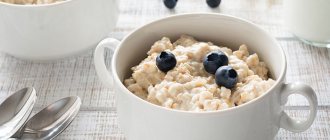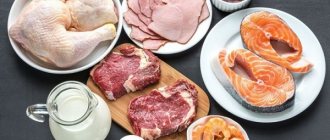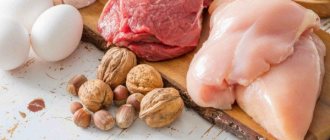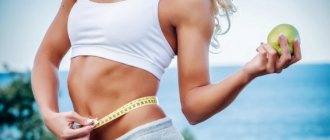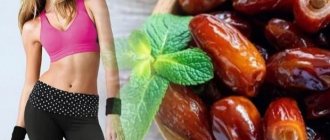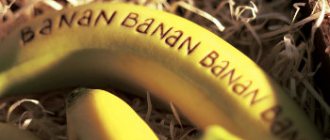There are many variations of the protein diet, so you can choose a sample menu for yourself for 10 days. The main thing is that your daily diet should include dairy products, fish and meat dishes. An absolutely safe diet that does not require painful restrictions and allows you to lose up to 7-10 kg. Today, a 10-day protein diet is one of the most relevant and easy ways to get rid of excess weight. Of course, combined with a little physical effort.
The essence and principles of the diet
A protein diet promotes active burning of fat in the body. Due to the fact that a person consumes only proteins, the body has to spend its previously accumulated reserves. The main source of energy is carbohydrates, and there are practically none of them in the diet. This approach starts the fat burning process already in the first days of the weight loss program. On day 2-3 of the diet you can achieve minus 1-2 kg. People who have too many extra pounds lose up to 10 kg.
To achieve such results, you need to know the basic principles of the diet:
- The number of meals per day should not be less than 5 times. You need to eat every 3 hours, with a snack between breakfast, lunch and dinner.
- The size of the dishes is small so that the portion fits in the palm of your hand. The diet is fractional, but frequent.
- We must not forget about drinking ordinary purified water. You need to drink up to 2 liters of liquid per day, not including tea, coffee, and juices.
- An active lifestyle, physical activity, and training in the gym do not stop during the diet. To avoid losing muscle mass, the intensity of physical exercise increases.
- Have dinner 3-4 hours before going to bed. If you have a strong feeling of hunger, then 1-2 hours before bedtime it is useful to drink a glass of kefir.
- For the entire day, food consumption should not be less than 1200 kcal. For men, this figure increases slightly, but it is better to calculate this indicator individually.
- Start every morning with a glass of clean water. You can drink liquid 20 minutes before meals, but not after. After eating, drinking water is allowed only 1.5-2 hours later.
- Food processing is carried out only by baking, stewing, boiling, but not by frying in a frying pan.
- It is necessary to include non-starchy vegetables with protein foods. The body must receive fiber and vitamins.
- 60% of the total diet during the diet consists of animal protein.
A dozen simple rules, if strictly followed, will allow you to forget about extra pounds for a long time, because after such nutrition, the lost weight does not return.
You might be interested in the article - What are the basic rules and principles of a diet for losing 20 kg?
Protein deficiency
Protein deficiency is a painful condition of the body associated with insufficient intake and absorption of protein or with its increased breakdown. A true deficiency in protein intake from food can develop in people who have been undernourished for a long time, adhering to so-called mono-diets, or in vegetarians. Secondary protein deficiency, associated with its increased breakdown, can accompany a number of diseases, for example, severe forms of infectious diseases, burns, kidney pathologies, and hereditary metabolic disorders. Proteins are the main building material of the body, so even mild forms of protein deficiency, which are outwardly asymptomatic, affect the ability to resist infection or the rate of wound healing, slow down the growth of nails and hair, and cause dry skin. Severe protein deficiency can disrupt the normal functioning of all organs and systems. Protein deficiency in childhood is especially dangerous, as it can affect the development of mental abilities, muscle formation, and slow down the child’s growth.
Timely detection of protein deficiency and establishment of its cause is extremely important, as it allows one to avoid life-threatening complications.
Synonyms Russian
Protein deficiency, protein dystrophy, protein-energy deficiency.
English synonyms
Protein Deficiency.
Symptoms
Mild forms of protein deficiency are most often asymptomatic. An exception may be hereditarily determined deficiencies of individual amino acids (structural components of the protein molecule), the characteristic signs of which are observed in early childhood.
External manifestations of protein deficiency:
- general weakness;
- progressive weight loss;
- fragility, dullness and hair loss;
- brittle nails;
- dryness and flaking of the skin;
- swelling.
Manifestations from the nervous system:
- lethargy and increased fatigue;
- headache;
- decreased mental activity;
- unstable mood;
- insomnia.
Manifestations from the musculoskeletal system:
- pain in muscles and less often in joints;
- slow growth (in children);
- reduction in muscle mass and apparent volume;
- muscle weakness.
From the digestive organs:
- increased craving for sweets;
- nausea;
- abdominal pain and bloating;
- stool disorders (constipation followed by diarrhea);
- liver enlargement.
Who is at risk?
- Population of countries with low living standards.
- Vegetarians.
- Persons following a mono-diet or fasting in order to lose weight.
- Patients with kidney diseases.
- Patients with diseases of the digestive system.
- Persons with a hereditary predisposition to protein metabolism disorders.
- Persons with professionally caused weight deficiency: ballerinas, models, gymnasts.
- Persons over 60 years of age.
General information about the disease
Proteins are among the essential nutrients that perform the following functions in the body.
- Construction - protein is part of all cells of the human body and, in fact, is the basis for the existence of life.
- Frame – proteins are involved in the formation of hair and nails, form the protective membrane of the eye, cartilage, tendons and ligaments. Even such a property as the smoothness of the skin directly depends on the protein it contains.
- Motor and contractile. Proteins are the main component of muscle tissue that ensures its functioning.
- Transport. Many proteins have the ability to bind to nutrients contained in the blood and transport them to organs and tissues. An example of a transport protein is hemoglobin, contained in red blood cells (erythrocytes) and transporting oxygen.
- Protective. The body produces specific proteins (antibodies) that provide protection against microorganisms and viruses.
- Enzymatic. Enzymes are proteins that are involved in all chemical processes occurring in the body (for example, in the digestion of food).
- Hormonal. Most of the hormones in the human body are proteins.
The implementation of these functions occurs due to protein metabolism - constantly occurring processes of protein formation (synthesis) and breakdown.
The main causes of protein deficiency:
- Severe and long-term illnesses require the body to use all its reserves. Proteins are spent to replenish energy costs and restore dead cells. In a number of diseases, significant protein loss occurs.
- Chronic kidney disease (glomerulonephritis, renal failure, nephrotic syndrome) can lead to the excretion of significant amounts of protein in the urine (proteinuria), causing a drop in protein levels and chronic protein deficiency.
- Liver cirrhosis and liver failure can cause protein deficiency, especially in the later stages of the disease, when edema develops - fluid containing large amounts of protein (ascites) can accumulate in the abdominal cavity. The liver synthesizes many proteins necessary for the body, and the digestive enzymes it produces are involved in their absorption. With cirrhosis, normal liver function is disrupted and protein deficiency may develop.
- Burns (burn disease). With thermal burns, blisters filled with protein-containing liquid may form on the skin. Protein losses when opening these bubbles can be quite significant.
- Diarrhea (diarrhea) is characterized by a significant loss of fluid and digestive juices containing proteins.
- Malignant neoplasms in late stages can lead to severe protein deficiency. The protein is spent on tumor growth, and is also lost during its decay and bleeding. Substances formed in tumor cells are foreign to the body. Once in the blood, they cause poisoning by decay products (cancer intoxication syndrome), one of the manifestations of which is a drop in protein levels.
- Diabetes mellitus can cause protein deficiency due to increased protein breakdown, as well as diabetic kidney damage and secondary proteinuria.
- Disorders of protein-amino acid metabolism. Proteins are complex substances that, like a chain, are made up of units called amino acids. The sequence of amino acids for each organism is individual, poe
Advantages and disadvantages
Before deciding on a protein diet, you should visit your doctor or nutritionist. Only a doctor can say how safe the selected menu is. This diet has its pros and cons, so you need to know them before you start changing your diet.
The disadvantages of a protein diet are:
- Minimum intake of vitamins by the body. To fill this niche, it is necessary to take vitamin complexes during the diet. It is better to coordinate the selection of vitamins with your doctor;
- The maximum duration of the diet is 10 days. There is no need to increase the duration of this diet so as not to harm your own health;
- An increased amount of protein provokes an exacerbation of chronic diseases;
- People with problems with the liver and kidneys have an increased risk of deterioration in health, since it is the excess of protein that directly impedes the functioning of these organs;
- A diet that avoids carbohydrates and fats provokes an increase in blood sugar and cholesterol.
Contraindications
In order not to harm your health, people suffering from the following diseases are better off giving up a protein diet:
- hepatitis (and other liver diseases);
- arrhythmia (and other cardiac abnormalities);
- kidney dysfunction;
- dysbacteriosis;
- colitis;
- pancreatitis;
- increased thrombus formation;
- joint pain (and all related ailments).
Also, the protein nutrition system is not suitable for older people, pregnant and lactating women.
Menu - table
A protein diet for 10 days, the menu of which is developed independently, may look like this.
| Day of the week | Breakfast | Lunch | Dinner | Afternoon snack | Dinner |
| Monday | 2 boiled eggs, black coffee | A glass of kefir | Rabbit soup with vegetables | Beet salad | Baked red fish, vegetable salad |
| Tuesday | Cottage cheese with herbs, tea | 2 apples | Vegetable stew with veal stew | Curd mass with dried fruits | Boiled chicken fillet with tomato sauce, 2 breads |
| Wednesday | Omelet, cucumber | 1 grapefruit | Fish broth, beet salad | Yogurt | Roast Turkey with Broccoli Puree |
| Thursday | Curd mass without sugar with black coffee | Vegetable salad dressed with yogurt | Steamed rabbit cutlets, salad | 1 boiled egg, bread | Boiled beef, lettuce, tomato and cucumber salad |
| Friday | Yogurt, 2 loaves | 1 orange | Chicken broth soup with green beans and celery | Beet salad | Fish cutlets with tomato sauce, tea |
| Saturday | Cottage cheese with herbs, 1 boiled egg | Kefir | Baked turkey with vegetables | Seafood salad | Cauliflower puree with boiled chicken fillet |
| Sunday | Omelet, black coffee | Sourdough without filler | Vegetable soup in beef broth with mushrooms | Beet salad | Curd mass, tea |
The presented menu can be changed by day. The diet of days 8, 9 and 10 is allowed to be repeated from any day of the diet. The main thing is to include beetroot salad from day 4-5, since protein foods can cause constipation.
How to cook?
Recipes for dishes for a protein diet are simple, even a novice cook can prepare them:
- Chicken broth soup with vegetables. For the soup, take the sirloin and cut it into pieces. Drain the first broth obtained and cook only with the second one. Add finely chopped green beans, bell pepper, and white cabbage to the boiled meat. When all the ingredients are cooked, add any greens to the soup. It is better to avoid salt;
- Baked salmon in the oven. Sprinkle fish fillet with lemon juice. Add fresh onion and celery if desired. Place vegetables on top of fish. Wrap the finished piece in foil and place in the oven for 15-20 minutes;
- Curd. This recipe is perfect for dessert. To prepare, just mix 150g of cottage cheese with 100 ml of natural yogurt. If desired, you can add fresh berries. Before serving, the mixture can be sprinkled with grated coconut on top;
- There is a large selection of recipes, so you just need to use your imagination.
We recommend that you familiarize yourself with the recipes for low-carb desserts.
Recipes for simple and tasty dishes
You should not include the same dishes in your diet for all 10 days - this will lead to exhaustion of the body. The diet should be as varied as permitted foods allow.
Protein salad:
- Boil and finely chop 150 g of squid and chicken breast.
- Boil 5 eggs. For the salad you only need whites, which need to be grated on a coarse grater.
- Mix meat, seafood, proteins, add fresh herbs.
- Season with lemon juice.
An original salad for an afternoon snack or dinner can be made from cottage cheese. Cut 300 g of cucumbers, 100 g of carrots and green apples into small strips. Mix vegetables and fruits with 250 g of low-fat cottage cheese. Season with natural yoghurt and a little lemon juice.
For dinner you can prepare an original casserole:
- Cut 250 g chicken fillet into thin slices.
- Boil 150 g of broccoli, puree in a blender.
- Prepare the sauce - mix 60 ml of natural yogurt, 20 ml of high-quality soy sauce, 5 mustard seeds.
- Add a little sauce to the puree, and evenly coat the pieces of meat with the rest.
- Place the fillet in layers in a baking dish, brush the top layer with broccoli puree.
- Bake in the oven for 30 minutes at 200 degrees.
For lunch, cook soups in chicken broth, add various vegetables - savoy cabbage, turnips, carrots, celery, mushrooms. Before serving, add fresh chopped herbs.
What can you do on a diet?
The list of allowed foods is rich, so meals during the diet can be varied. What can you cook with? These products are:
- All types of meat, but not fatty parts;
- Sea fish;
- Eggs;
- Mushrooms;
- Fermented milk products with a low fat content;
- Non-starchy vegetables (cucumbers, zucchini, eggplants, peppers, cabbage of all types).
It is allowed to drink various teas and black coffee, but without sugar. It is also useful to consume natural juices.
You should not give preference to carbonated water, because it can provoke a feeling of hunger.
Permitted and prohibited products
During a protein diet for weight loss, you can prepare dishes from any lean meat, sea fish and seafood, eggs, mushrooms, you can eat fermented milk products of medium fat content, and hard cheeses. For side dishes and soups, use zucchini, peppers, cucumbers, tomatoes, and any varieties of cabbage.
Prohibited products:
- sugar in any form, baked goods, muffins;
- butter and vegetable oil;
- fatty meats;
- sausages;
- porridge, pasta;
- bananas, grapes, potatoes, legumes;
- semi-finished products, canned food, fatty store-bought sauces;
- alcoholic, carbonated, energy drinks.
It is better to completely avoid black coffee and strong tea, and reduce the amount of salt to a minimum. You can drink rosehip decoction, herbal teas, and natural juices.
In some versions of the protein diet, it is allowed to consume no more than 7 tbsp. l. porridge in the morning. It can be oatmeal in water, brown rice, buckwheat, cooked until half cooked.
What can't you do on a diet?
The protein diet does not allow the consumption of the following foods:
- All types of sweets;
- Sugar;
- Flour products;
- Baking;
- Fatty meat (pork);
- Sausages;
- Semi-finished products;
- Alcohol;
- Cereals;
- Sweet fruits (banana, grapes);
- Starchy vegetables (legumes, potatoes);
- Mayonnaise, any fatty sauces.
There should be no fats or carbohydrates in the diet, so this factor is important to consider first.
The main principle of the method
The secret of the protein-vitamin diet is that protein and vitamin components are consumed alternately, during delimited meals. This technique embodies the basic requirements of separate power supply. When digesting single-component food in the stomach, processes occur faster than in the case of complex compounds. Pepsins break down the food bolus much faster, and it enters the intestines at an accelerated pace. Fast transportation and digestion times ensure the absorption of fewer nutrients and acceleration of metabolic processes, due to which weight is actively reduced.
Meals occur 5-6 times a day at intervals of about 2-2.5 hours. Due to the fact that the intervals between meals are such a short period of time, the feeling of hunger does not have time to set in.
The effectiveness of the diet is based on the limited consumption of fats and carbohydrates while actively saturating the body with vitamins contained in large quantities in raw vegetables and fruits, and providing the protein component responsible for the basic functions of life.
The protein-vitamin diet is designed for 10 days, but for the first time you can try to stick to it for a shorter period (for a week) to determine whether it is suitable.
Despite the fact that the diet promises weight loss of up to 10 kg per decade, it all depends on individual characteristics, such as initial weight, metabolic rate, and “rigor” in following the rules of this type of nutrition. But in any case, this diet is effective and relatively easy to tolerate.
Products prohibited for consumption
In the case of vitamin and protein nutrition, the list of taboo foods applies to most diets:
- sweets;
- bakery;
- dried fruits;
- nuts and seeds;
- sweet high-calorie fruits (persimmon, banana, apricot, grapes, mango, passion fruit, papaya);
- potato;
- carrot;
- peas;
- oil;
- cream;
- salo;
- bread;
- cereals;
- ketchup;
- sour cream;
- soy sauce;
- mayonnaise.
Salt is allowed to be used as a seasoning, but it is also advisable to reduce its use to reasonable standards if very salty food is often present on the table. When cooking, you can add black and white pepper and Provençal herbs to dishes.
Among drinks, carbonated water is prohibited due to its irritating effect on the mucous epithelium of the gastrointestinal tract. Also excluded are sweet carbonated drinks, juices from the store that contain preservatives, coffee and alcohol. You can only drink tea without sugar.
Varieties
The protein diet has several varieties, so those losing weight can choose from the following options:
- Atkins Diet;
- Egg White Maggi;
- Japanese;
- Protein-vegetarian;
- Ducan's diet;
- Express diet on proteins;
- Vitamin and protein.
Each diet is different, so before making your final choice, it is better to know all the pros and cons of the chosen diet.
Side effects
If you do not follow the rules of dietary nutrition, you can get the following as adverse reactions:
- Headache;
- Weakness;
- Dizziness;
- Nausea;
- Reduced blood pressure;
- Constipation;
- Flatulence;
- Deterioration of skin color;
- Increased irritability.
Such changes in well-being develop first, so you should not wait for the situation to improve. At the first indisposition, it is better to abandon the diet.
